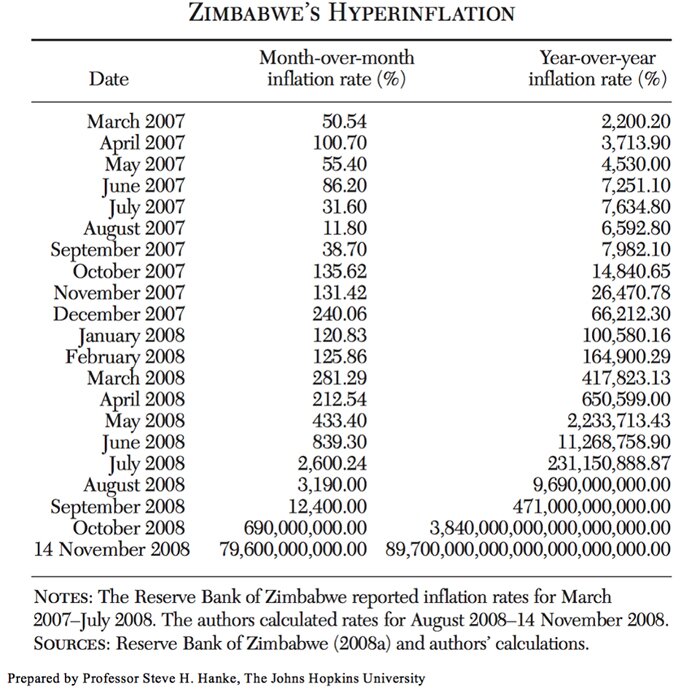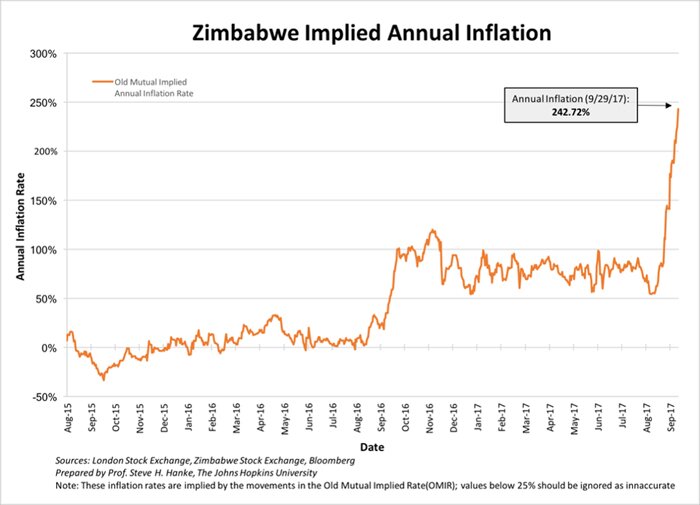In November 2008, Zimbabwe experienced the second-highest recorded inflation rate in history, and with that, it entered the Hanke-Krus World Hyperinflation Table. That’s when the annual inflation rate reached a peak of 89.7 sextillion (1021) percent (see table below).
At this point, prices were doubling every 24.7 hours. During Zimbabwe’s hyperinflation episode (2007-2008), the Reserve Bank of Zimbabwe failed to report any meaningful economic data, including inflation rates. I, assisted by my capable team at Johns Hopkins University, was the only reliable source accurately measuring inflation during Zimbabwe’s hyperinflation episode.
Zimbabwe Hyperinflation
Just how was I able to do that? During episodes of hyperinflation, the only reliable and feasible way to measure inflation is via the application of Purchasing Power Parity (PPP). To do that, one needs data on the most important price in the economy: the exchange rate between the domestic and a stable international currency. This was not feasible in Zimbabwe. The Zimbabwe dollar was not traded on an organized exchange that reported exchange rates. Moreover, there were multiple black-market (read: free market) exchange rates for cash, as well as non-cash Zimbabwe dollars (credit and debit cards, checks, and bank transfers). So, the use of black-market exchange rates was not feasible, either.
Due to the lack of necessary data, it appeared that the measurement of Zimbabwe’s inflation rate would be impossible. But, the organized stock market in Harare did provide prices that allowed me to calculate Zimbabwe dollar exchange rates. This was done in the following way. One stock—that of the insurance and investment company Old Mutual—is listed on both the London Stock Exchange and the Zimbabwe Stock Exchange. Each share of Old Mutual commands the same claim on the company’s earnings and assets, irrespective of the market it is traded on. The only difference between Old Mutual shares traded on different exchanges is that the shares traded in London are denominated in British pounds sterling; whereas, those traded in Harare are denominated in Zimbabwe dollars. Therefore, if price arbitrage works and PPP holds, the ratio of the Old Mutual share price in Harare to that in London equals the Zimbabwe dollar/sterling exchange rate. To convert the resulting Zimbabwe dollar/sterling exchange rate to a Zimbabwe dollar/U.S. dollar rate, I multiplied the Zimbabwe dollar/sterling rate by the sterling/U.S. dollar rate, creating what is known as the Old Mutual Implied Rate (OMIR).
By using the OMIR as an exchange rate between Zimbabwe dollars and USD, I was then able to apply PPP theory to transform this exchange rate into an estimate of the percentage change in the Zimbabwean price level. This yield an accurate estimate of the implied inflation rate for Zimbabwe during the 2007-2008 period.
At the peak of Zimbabwe’s hyperinflation episode in November 2008, Zimbabweans refused to use the Zimbabwe dollar. With that, the economy was spontaneously, and unofficially, dollarized. Eventually, the government faced this fait accompli in early 2009, when they dollarized the economy by accepting the dollar as the unit of account for government finances.
Under this dollarized regime, Zimbabwe’s fiscal authorities could no longer demand that the Reserve Bank of Zimbabwe supply the government with credit (read: print money). This hard budget constraint became too onerous for the free spending government to abide by. In consequence, Zimbabwe’s government has employed Harry Houdini’s magic and circumvented the hard budget constraint imposed by dollarization. It has done so by creating a new fake dollar, which is referred to as the “New Zim Dollar.” Not surprisingly, this new Houdini creation is rapidly becoming worthless. This makes the methodology that I employed to measure inflation during Zimbabwe’s hyperinflation episode relevant again. Since Old Mutual’s price on the Zimbabwe Stock Exchange is denominated in “New Zim Dollars” and Old Mutual’s price on the London Stock Exchange is denominated in British pound sterling, we can create a “New Zim Dollar”/sterling implied exchange rate. This exchange rate can be transformed using PPP to accurately measure Zimbabwe’s inflation. At present (09/29/17), Zimbabwe’s annual inflation rate has soared to 242.72%. This makes it the second highest inflation rate in the world after Venezuela (see chart below).
Zimbabwe Implied Annual Inflation


